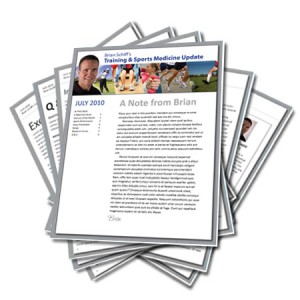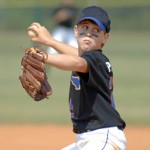Brian Schiff’s Blog
Injury Prevention, Sports Rehab & Performance Training Expert
As a parent, coach and sports physical therapist, this is a topic I am both passionate about and often confronted with. I remember growing up in a small town where I played a different sport every season. No one played year round soccer, baseball or AAU basketball – it was not even an option for those around me.
Now, I live and work in a competitive sports-minded environment where I see 13 y/o baseball pitchers with elbow and shoulder pain, 13 y/o female soccer players with ACL reconstructions, and too many adolescents suffering from overuse injuries like anterior knee pain and tendonitis. I witness coaches teaching 10 and 11 year olds to throw curve balls, hear athletes tell stories about how they are strongly encouraged or pressured to play only one sport if they want to excel and make a team, and parents who are pushing their kids hard at an early age in pursuit of college scholarships.
Is it all worth it? In a short answer – NO. In a recent article in the May/June 2013 issue of Sports Health, Jayanthi et al. performed a comprehensive search of PubMed and OVID from 1990-2011, gathering articles discussing sports specialization, expert athletes, or elite versus novice athletes including original research articles, consensus opinions, and position statements.
Click here to read the abstract
My own personal bias and opinion is that we should encourage youth to participate in multiple sports/activities and not pursue one sport or activity until they reach high school. I believe there is so much to be gained in terms of coordination, neuromuscular training, recovery and building general athleticism that gets lost with early specialization. However, I see many young athletes swept into early development programs and travel/AAU teams that naturally discourages or eliminates time/opportunities for other activities.
With that said, I will readily acknowledge that certain sports/activities (gymnastics and playing an musical instrument for example) do require an early commitment in terms of practice and skill mastery if one is to reach elite status. So, what should we as health and fitness professionals be telling our clients? How intensely do they need to train and at what age is it okay to focus on one sport?
I think we need to know what the evidence we have says and how we can best use knowledge to make meaningful change in society. In addition, we need to evaluate the mental and physical injuries that are occurring with the choice to specialize at a very young age. Consider that participation at age 6 and under has increased from 9 to 12% from 1997 to 2008.
So, for us to make a difference we need to investigate and scrutinize how we coach and train young athletes and become an advocate for their long term health as well as short term success.
Here are the key bullet points from the article I referenced above:
- Coaches are the most influential in beginning intense training and the decision to specialize
- Less than 1% of athletes 6-17 years old achieve elite status in basketball, soccer, baseball, softball or football
- Early diversification is more likely to lead to success based on multiple studies and may lead to more enjoyment, fewer injuries and longer participation
- Early diversification is more likely to lead to success based on multiple studies and may lead to more enjoyment, fewer injuries and longer participation
- Data currently suggests enjoyment of sport and intrinsic motivation predicts attainment
- Exposure is the most important risk factor for injury and there is a significantly increased risk for injury when participating > 16 hours/week
- Cumulative match exposure also carries a significant injury risk
- Prospective 10 year analysis of 481 youth baseball pitchers reveals a 3.5x increased risk for injury when pitching more than 100 innings per year
What about burnout? Consider the following:
- Swimmers who specialized early spent less time on the National team and retired sooner
- Minor league hockey players (boys) who dropped out started earlier and spent more time in off-ice training than those who continued to compete
- One retrospective review revealed that 1 out of 5 elite athletes reported injury as the reason for quitting
- In the end, the authors conclude that some specialization is necessary to attain elite skill, but the exclusion of other activities should be delayed until late adolescence.
To foster diversification, we must do a few things in sports medicine:
- Educate parents, coaches and athletes on the injury risk and facts about the impact of early specialization
- Promote the benefits of diversification in terms of joy, diminished stress to excel, athletic development and physical recovery
- Remind everyone involved not to take sports too seriously as only a very select few will move on to elite status, and instead encourage them to enjoy competing, learn to be a good teammate and reap the other rewards in sports (discipline, sportsmanship, learning to overcome adversity, working hard to achieve a goal, etc) that last well beyond a trophy presentation or game
I was just asked a few days ago by the parent of a 9 year old baseball player if I thought it was good for him to play multiple sports since he is pretty good in baseball. I encouraged this mother to have him do as many sports as he can for the next several years. Why put so much pressure on kids and expose them to increased injury risk? Every family and athlete needs to make their own personal decision, but for those who do opt for early specialization, I want to make sure I can help educate them on cross training, rest and recovery to minimize the risk for burnout and injury.
I have spent the past 16 years helping athletes get back to their sport or desired activity following an injury. Whether dealing with muscle strains or ACL ruptures, every injured client shares the same goal of making a full recovery and getting back to their previous activity level. My purpose in writing a blog series on this topic is simply to share some pearls I have picked up along the way and to help others learn from my mistakes and successes.
Beyond the severity and nature of the injury itself, there are several considerations that play a significant role in the rehabilitation process including: the athlete’s emotions, goals, mental toughness, age, experience, previous medical history, relationships with parents/coaches/teammates, innate movement patterns, etc. I feel the first and perhaps most important step in the recovery process involves connecting with the athlete on an emotional level.

Injured clients want to know that their medical team (MD, PT, ATC and strength coach) really care about their well being, that they truly understand the impact of the injury on his/her life, and that they can provide the skilled care necessary to restore the body to its prior level of function. Too many times, we as health care professionals speak first espousing all our expertise and often forget to LISTEN enough. Our athletes want to feel special during this low point in their life.
Pearl #1 – Spend more time listening on the first meeting/visit to gain a thorough understanding of how the injured athlete “feels” and views their current injury. I spend the majority of my eval time interviewing the client to allow them to describe their physical symptoms, but more importantly fully elaborate on their goals, perceptions and thought processes surrounding the rehab timeline and expected outcome. Knowing how they feel (afraid, angry, depressed, etc) is essential in order to connect as well as properly motivate/coach throughout.
Many athletes (especially those who have been injured before) tend to want to dictate how things will go or pre-determine when they will be able to return to the playing field. I will re-direct them, but it is wise to listen to them tell you what did not work for them in the past. Mistakenly, they often compare their injuries to past experiences of their own or peers. While prior experience dealing with the same injury is helpful mentally preparing for the recovery process, it is critical to remind the athlete coach and family that no two injuries are exactly alike and that the recovery process will be guided by specific milestones and processes as opposed to “what happened in the past.”
Pearl #2 – Thoroughly educate the athlete on his/her condition, the anticipated timeline for return to sport and the implications for pushing too hard and fast in rehab. Never assume he/she does not want to know all the details. Emphasize that your goal is to return to sport as soon as possible but in a safe manner that ensures adequate recovery and minimizes the risk for re-injury. Telling your athletes the “why” behind each and every decision (exercise selection, reps, sets, practice limitations, etc) will help put the athlete at ease early on and foster trust and collaboration. This is an absolute must. To ensure success, we need the athlete to honestly and openly communicate throughout. I tell every athlete I work with that we are a team dedicated to the same goal – this achieves buy in from them up front as they see I am fully committed and invested in them.
In almost all cases, I find the athletes fear losing their starting position and/or letting down the coach far more than long term damage to their bodies. As such, I tell them it really is okay to rest and recover. They seemingly feel guilty about not contributing and their self-worth may markedly diminish. Recognizing this and encouraging them to be patient, stay the course and see the light at the end of the tunnel is very important. You see, the emotional and psychological healing is a HUGE part of the process during rehab. Being an advocate for the patient and not the sport provides security and emotional support for the injured client.

A quick note for those who follow my blogs. I have been wanting to launch two new information based platforms this year: a monthly printed newsletter and online membership site. What I have realized is that I am so busy I will likely not get both done in 2010 as I am also working on my Fit Knees DVD series as well as running my training business.
So, I have prioritized the printed newsletter titled Brian Schiff’s Training & Sports Medicine Update. My love and passion lies in sports medicine, injury prevention and sports performance training. So, the newsletter will have the following components:
- Exercise of the month – I will share pics and how to info with you
- Sports performance – topics relevant for athletes and weekend warriors
- Injury prevention – tips on how to stay injury free
- Rehab – advice on how to rid yourself of aches, pains and injuries
- Research corner – review of current pertinent research and trends
- Q & A – ask me your own questions about training and injuries
My goal for this publication is to deliver solid up to date information for coaches, ATC’s, physical therapists, parents, weekend warriors and athletes seeking information on how to be their physical best and remain injury free. You can see the art for the inaugural issue soon to be released below.

For more information and to stay updated on the official launch, be sure to sign up for my newsletters at www.brianschiff.com. I will be offering a special launch price to the first 100 subscribers. I look forward to helping you stay healthy and performing optimally for many years to come.
At this phase of my career, I have been around long enough and successful (or rather blessed) enough to be considered an expert in my field. This affords me the opportunity to see and work to fix complicated client issues as well as teach others how to do the same.
One mistake I see time and time again in rehab and sports training is a lack of sound sequential and functional progression. I blame part of this on the demise of insurance programs as we once knew them as therapy sessions are now limited both in scope of coverage and number of visits. But, the rest of the blame often falls squarely on the shoulders of therapists, doctors, sports performance specialists and coaches. Okay, parents may deserve a spot in my blame circle too.

Why do I say blame? Well, to be honest we often mislead or let down athletes recovering from injury by not listening enough, pushing them too hard, not pushing them hard enough, using outdated or irrelevant protocols, or incorrectly assuming they will heal like the last person with injury X. Sound at all familiar? Ever wonder why some people with the same injury recover differently and/or suffer a re-injury so soon after going back to sport?
Now, read on as this blog post is not a rant. The point I want to be crystal clear on is that we as caretakers and health providers of young athletes must be on our game at all times. This means we must be willing to continually learn and drop our assumptions, standard protocols, experiences and such at the door each time we see a new case. We must apply and adjust our plan based on each individual we see.
Ont thing I am certain of is that no two humans are exactly alike. Therefore, we must consistently assess and re-assess. I believe the real magic if you will that at times occurs for me with my athletes is less a result of my own doing and more a result of my intuition and ability to communicate and extract information at critical times from my clients.
You may think that this happens in every therapy clinic and sports training realm, but trust me when I say that line of thinking is naive. I have personally heard and witnessed too many failed rehab stories and examples of lackluster care/training to validate it. As trainers and rehab specialists, we must be willing to do the following to maximize the success of our clients:
- Listen to the spoken and unspoken words
- Observe everything (movement, emotion, and facial expressions)
- Encourage the athlete or client to communicate freely, frequently and most importantly honestly
- Craft a daily plan based 100% on how the client is doing at that very moment in time – this is tough as you may have to scrap your entire preplanned workout
- Challenge our own beliefs, assumptions and strategies all the time – it becomes easy to get stuck in a rut or fall back on doing the same thing for similar problems. We must guard against complacency in our programming. We must always seek new and better ways to do things.
- Involve the athlete/client in the decision making process – in other words explain the “why” behind things and relate it to their activity, rehab or sport. Most of the time they will work harder and cooperate more when you do this simple thing.
- Provide routine progress updates verbally (I call them affirmations) to the client and their family. We all like to know how we are doing and being vague and having no clear direction or goals is simply unacceptable. Encourage your clients and let them know how they are progressing in straightforward terms.
These are just the seven biggies that come to my mind right now. The takeaway here is that training and rehab is and always should be exacting, yet flexible at the same time. Fluid, seamless tweaking and adjusting are hallmarks of all the greats. Clients should accept nothing less than this precise, analytical and results driven process, nor should we be willing to offer any less.
Following this blueprint will accelerate recovery, maximize performance gains and minimize injuries. Isn’t that what it is all about? Here’s to harnessing our passion and giving the absolute BEST to those we are fortunate enough to serve.
I am often asked when is it safe to go back to play after an injury. In most cases, I am dealing with lower body or back injuries with my athletes, so for the purposes of this post, I will address a lower body functional return to play paradigm.
The tricky part about this question is that no two injuries are created equal. Sure, I will be the first to acknowledge that I have general approaches to certain injuries and have a sense of how long it should take most of the time. But, over the past 13 years I have seen enough irregularity and differences to say that everyone heals and recovers differently.
For example, I have had athletes with a simple grade 1 ankle sprain not go back to sport for 6 weeks, whereas those with much more severe grade 2 or even grade 3 sprains go back in much less time. Why? There may be several reasons including compliance, body structure, previous medical history, fitness, pain tolerance, and the quality of the rehab to name a few.
In the end, rehab professionals and strength coaches must have sound knowledge of pathophysiology, tissue healing, and program design that ensures maximal progression with optimal tissue loading. Messing up the stress gradient (too little or too much) will slow the return to play process. Below are some major milestones my athletes must clear in order before we even get to what I term “functional rehab” or preparatory movement prior to controlled practice:
- Full active range of motion
- Normal strength on muscle testing
- Normal walking gait
- Symmetrical squat and lunge patterns
- Single leg squat (back, hip or knee injury) and/or calf raise (ankle injury) within normal limits compared to uninvolved side
- Single leg hops in place x 10 equal to uninvolved side with no pain or instability
- Normal running gait on treadmill x 5′ without pain or instability
- Lateral gait cycle within normal limits (shuffle, carioca and cross stepping)
- Planned and predictive controlled agility without pain or instability
- Low level plyometrics in 3 planes without pain or instability
After moving through this fundamental progression (may take days or weeks), the athlete may then begin to perform more demanding neuromuscular work. This would involve more rotational work, full intensity sprints an cutting, and gradually the transition to reactive agility and speed drills. Once the athlete completes this process, he or she is ready for controlled practice.
This is an area where I see student athletes get in trouble. They get “cleared” so to speak by the MD and go back to practice. Cleared to a coach means full go, right? The athlete should ease back into practice even after a carefully prescribed rehab plan like the one I just laid out. However, too often, I see athletes rushed back to full practice too soon. In the case of soft tissue and stress reaction injuries, this often sends them back to the training room or sideline much sooner than the coach or athlete would like.
What is the answer? Controlled practice progressions with the idea of first increasing volume (total minutes) prior to restoring maximal intensity. Athletes know what is hard and what hurts. We just need to communicate with them. Allow them to do the easier drills and fill up time with those prior to ramping up the intensity for the entire practice.
Let’s take soccer as an example. Dribbling, passing and light shooting are lower level drills. In contrast, set pieces and small sided games are much more demanding. Athletes and coaches must use discretion when returning form play to avoid re-aggravating an injury. Measuring pain before, during and for 24 hours afterward is crucial in determining how the body is absorbing the force and responding to the training stress.
If soreness is lingering for more than 24 hours, this is a red flag that the volume and/or intensity is too much. I educate all my parents, coaches and athletes to follow this simple 24 hour rule. I have found if you do, you end up with predictable results in terms of recovery and return to play. So, if you have suffered an injury, be sure to consider moving through a set functional progression and be sure to used a controlled return to play approach to ensure you make a full recovery. Have questions? Leave a comment or shoot me an email.




